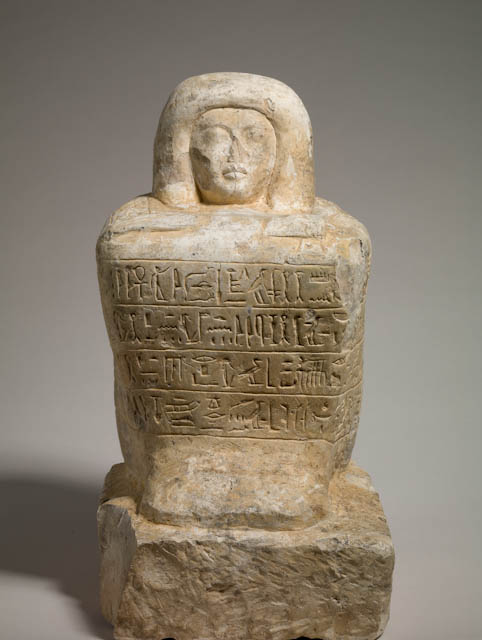| Maker(s): | Unknown | | Culture: | Egyptian
| | Title: | Block statue of the scribe Amunwahsu
| | Date Made: | 1386-1278 BCE (New Kingdom, late Dynasty 18-early Dynasty 19)
| | Type: | Sculpture
| | Materials: | Limestone and plaster, originally painted
| | Place Made: | Africa; Asia; Egypt
| | Measurements: | Overall: 15 3/4 in x 7 7/8 in x 11 5/8 in; 40 cm x 20 cm x 29.5 cm
| | Narrative Inscription: | INSCRIPTION: circumscribed: The Scribe of the Offering Table of the Lord of the Two Lands, the Conductor of the Festival of Osiris....Amunwahsu, Justified. He says: "O living ones who are upon earth, ordinary (wab) priests, lector priests, God's fathers, noblemen, magistrates of the temple of Osiris / the entire priesthood of the temple, (anyone who passes by this) statue: The God Ptah, South of His Wall, will commend you and you will bequeath your offices to your children after / a long old age, if you recite; 'an Offering Which the King Gives, to Osiris, Foremost of the Westerners, and [to] Geb, Hereditary Noble of the Gods [consisting of] bread, beer, oxen, fowl, linen, incense and unguent, for the spirit (ka) of / the Scribe of the Offering Table of the Lord of the Two Lands, Wahw [sic], Justified.' I am trustworthy, free of wrongdoing, established, one who does not associate with wrongdoers. I know what the God abominates.; left shoulder: The Keeper of the Door of Ta-Inet, Wahsu, Justified.; right shoulder: Osiris, Lord of Eternity.
| | Accession Number: | MH 1956.36.A.G
| | Credit Line: | Gift of Mrs. Trent McMath
| | Museum Collection: | Mount Holyoke College Art Museum
|
|

Currently on view |
Description:
Block statue of the scribe Amunwahsu. Statue of a seated man with knees drawn up and body covered by a cloak, with head and hands emerging above the cloak. Four lines of text with request for offering prayers wrap around front and two sides of figure. Additonal texts are inscribed on the shoulders.
Label Text:
Block statues showing seated figures with their knees drawn up under a cloak could be placed in temples by those who were granted permission. There they could share in offerings for the gods and became spectators at religious festivals. The broad surfaces provided space for prayers to be inscribed and the compact shape made the sculpture resistant to damage. In this example, Amunwahsu, Scribe of the Offering Table of the Lord of the Two Lands, solicits passersby to recite an offering formula on his behalf, thereby bringing him perpetual sustenance. Tangible gifts of food may also have been placed on the flat area at the top of the statue.
On the left shoulder is inscribed: “The Keeper of the Door of Ta-Inet, Wahsu, the vindicated” and on the right: “Osiris, Lord of Eternity.”
The inscriptions on the body of the block statue reads:
The Scribe of the Offering Table of the Lord of the Two Lands, the Conductor of the Festival of Osiris…, Amunwahsu, the vindicated. He says: “O living ones who are on Earth, ordinary priests, lector priests, God’s fathers, noblemen, magistrates of the temple of Osiris, the entire priesthood of the temple, [anyone who passes by this] statue: The God Ptah, South of His Wall, will commend you and you will bequeath your offices to your children after a long old age, if you recite: ‘an offering which the King gives to Osiris, foremost of the westerners, and [to] Geb, Hereditary Noble of the gods, [consisting of] bread, beer, oxen, fowl, linen, incense and unguent, for the spirit of the Scribe of the Offering Table of the Lord of the Two Lands, Wah[s]u, the vindicated.’ I am trustworthy, free of wrongdoing, established, one who does not associate with wrongdoers, I know what the God abhors.
2016
“I am trustworthy, free of wrongdoing, established, one who does not associate with wrongdoers.”
Amunwahsu, a scribe from Egypt’s New Kingdom (ca. 1550-1070 BCE), appeals to passers-by to recite the sustenance script encasing his statue. The offering text assures divine reward to whoever recites it. Ancient Egyptians believed that each person possessed a complex soul that survived the body’s death but needed all the provisions of life on earth, protection provided by spells, and a physical representation to survive in the underworld. With approval from the Pharaoh, private individuals of status commissioned block statues like this one to reside in temples, signifying their continued participation in sacred rites and ensuring a channel for nourishment after death.
Reflecting Ancient Egyptians’ concern with eternity, this sculpture provides not only for the immortality of the individual it represents, but also in its very solidity and substantiality, ensures its own enduring presence. By providing a historical record of ancient Egyptian culture for subsequent civilizations, Amunwahsu truly fulfills his role as a scribe.
-Victoria Schmidt-Scheuber (Class of 2012), Mount Holyoke College
Global Perspectives: Exploring the Art of Devotion (February 9 - May 30, 2010)
Block statues showing seated figures with their knees drawn up under a cloak could be placed in temples by those who were granted permission. There they could share in offerings for the gods and became spectators at religious festivals. The broad surfaces provided space for prayers to be inscribed, and the compact shape made the sculpture resistant to damage. In this example, Amunwahsu, Scribe of the Offering Table of the Lord of the Two Lands, solicits passersby to recite an offering formula on his behalf, thereby bringing him perpetual sustenance. Tangible gifts of food may also have been placed on the flat area at the top of the statue.
1997
Tags:
ancient; archaeology; sculpture; deaths; afterlife; deities; deities; religion; male; men Subjects:
Men; Religion; archaeological objects; Civilization, Ancient; Death; Future life; Gods; Males; Sculpture Link to share this object record:
https://museums.fivecolleges.edu/detail.php?t=objects&type=ext&id_number=MH+1956.36.A.G |